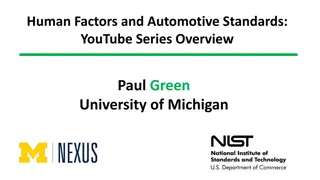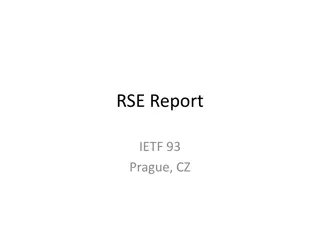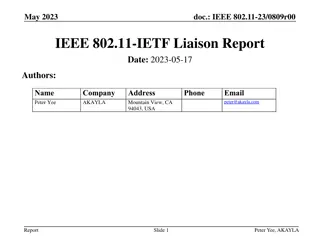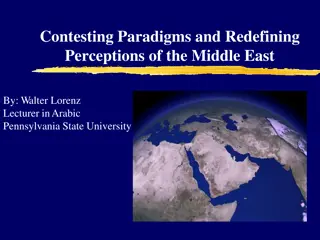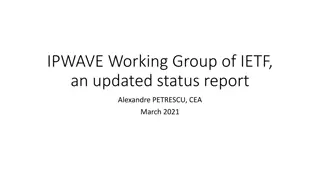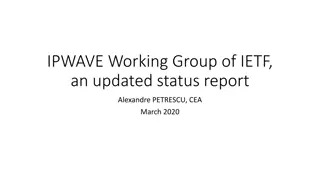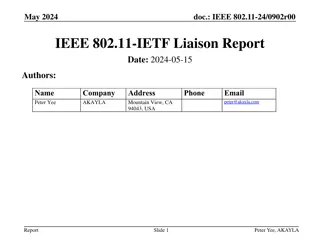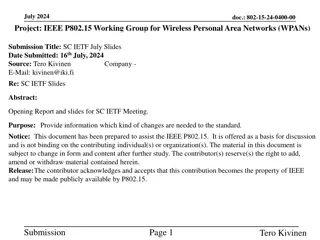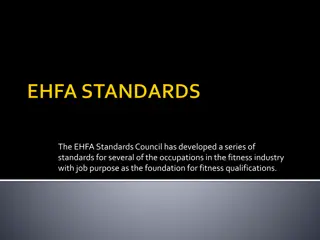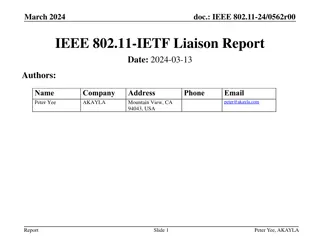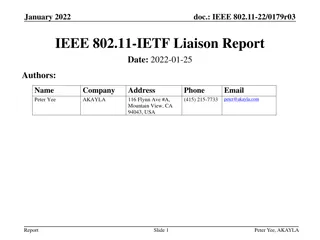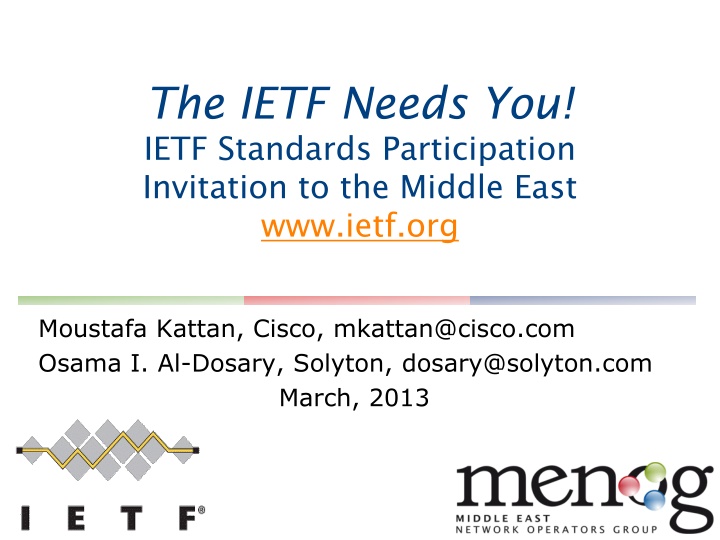
IETF Standards Participation in the Middle East
The Internet Engineering Task Force (IETF) plays a crucial role in developing and promoting IP-related standards, collaborating with organizations like IEEE and ITU. The IETF follows a unique standardization model, where decisions are made based on rough consensus. With over 100 Working Groups organized into different Areas, the IETF covers a wide range of subjects, from routing to security. Active participation in IETF liaison work and engagement in various technical discussions foster innovation and advancement in global telecom architecture and standards.
Download Presentation

Please find below an Image/Link to download the presentation.
The content on the website is provided AS IS for your information and personal use only. It may not be sold, licensed, or shared on other websites without obtaining consent from the author. If you encounter any issues during the download, it is possible that the publisher has removed the file from their server.
You are allowed to download the files provided on this website for personal or commercial use, subject to the condition that they are used lawfully. All files are the property of their respective owners.
The content on the website is provided AS IS for your information and personal use only. It may not be sold, licensed, or shared on other websites without obtaining consent from the author.
E N D
Presentation Transcript
The IETF Needs You! IETF Standards Participation Invitation to the Middle East www.ietf.org Moustafa Kattan, Cisco, mkattan@cisco.com Osama I. Al-Dosary, Solyton, dosary@solyton.com March, 2013
Internet Engineering Task Force Develops and promotes IP related standards. Doesn t standardize transmission hardware. Organizations like the IEEE and the ITU do. Example standards are numerous and range from routing protocols such as bgp, rip, nat,, ipsec, snmp, etc. to general application level protocols like http, pop, smtp, telnet, dns, etc. The IETF however does liaison work with both and other bodies when needed.
IETF ITU-T Liaison Work Charter Charter: Global Telecom : Global Telecom Architecture Architecture and Standards Standards Charter Charter: Evolution of the : Evolution of the Internet (IP) Architecture Internet (IP) Architecture (MPLS, MPLS-TP, Control Plane) and Member Organizations: Global Service Providers Telecom equipment vendors Governments ---ASON Active Participants: Service Providers Vendors ---WSON WSON Optical Impairment Aware Work Group: http://tools.ietf.org/html/rfc6566 Based on ITU-T impairment parameters G.680
IETF Standardization Model a loosely organized group of people define protocol specifications, usage and implementations. Decisions based on rough consensus : raising hands in the room & explicit questions on the mailing lists Anyone can show up and pose questions or comments. There are only individual contributions (not companies).
IETF Organization Areas & WGs (Working Groups) Its organized into many Areas lead by an Area Director. There are 8 Areas & each Area is subdivided into multiple Working Groups (WG). There are over 100WGs. Each WG has a charter and disbands once work is complete. The WGs are divided into several Subject Matter Areas
WG IETF Organization bfd ccamp mpls pce ospf l2vpn l3vpn karp Area General Internet Routing Application Real-Time Security Transport IETF 6
E.g.: Routing Area Active Working Groups ccamp pce mpls bfd isis karp l2vpn l3vpn manet nvo3 ospf pim Common Control and Measurement Plane Path Computation Element Multiprotocol Label Switching Bidirectional Forwarding Detection IS-IS for IP Internets Keying and Authentication for Routing Layer 2 Virtual Private Networks Layer 3 Virtual Private Networks Mobile Ad-hoc Networks Network Virtualization Overlays Open Shortest Path First IGP Protocol Independent Multicast
CCAMP WG and related WGs CCAMP (Common Control and Measurement Plane) The main WG where the GMPLS and control plane activities take place. CCAMP has been re-chartered to include control plane for Ethernet networks. PCE (Path Computational Element) Since it s an architectural option that fit with optical networks. Lots of GMPLS extensions are moving to PCE as well MPLS Since GMPLS is a generalization, MPLS-TE extensions also take place in CCAMP.
IETF Standards Document Flow draft-<name>-<something>-00.txt Individual Submission 01.txt etc. draft-ietf-ccamp-<something>-00.txt Working Group Document 01.txt etc. RFC rfcXXXX.txt
Additional List of CCAMP Drafts WSON (Wavelength Switched Optical Network) with Optical Impairments http://tools.ietf.org/html/draft-martinelli-ccamp-wson-iv-info-01 http://tools.ietf.org/html/draft-martinelli-ccamp-wson-iv-encode-01 http://tools.ietf.org/pdf/draft-kattan-wson-property-01.pdf WSON MIBS http://tools.ietf.org/id/draft-gmggm-ccamp-gencons-snmp-mib- 00.txt http://tools.ietf.org/id/draft-gmggm-ccamp-wson-snmp-mib-00.txt FlexGrids http://tools.ietf.org/html/draft-ogrcetal-ccamp-flexi-grid-fwk-02
Why Participate? Help better represent our region in the global community. Contribute to continuous development of the Internet. Help influence the future of the Internet based on regional needs. Be part of the innovation and thought leadership, and part of history.
Call to Action:Join an IETF WG now! Next Meeting: IETF-87 Berlin, July 2013 http://www.ietf.org/meeting/upcoming.html The IETF is completely open to newcomers. There is no formal membership. Meeting attendance is optional ($650 entrance) Every WG has a dedicated mailing list, and that's where proposals are made and discussed, and where consensus is established. To START: Decide on one or two (not more!) WGs whose topics are interesting to you, and join their mailing lists.
Questions? 15

![READ⚡[PDF]✔ Emerging Space Powers: The New Space Programs of Asia, the Middle Ea](/thumb/21554/read-pdf-emerging-space-powers-the-new-space-programs-of-asia-the-middle-ea.jpg)
